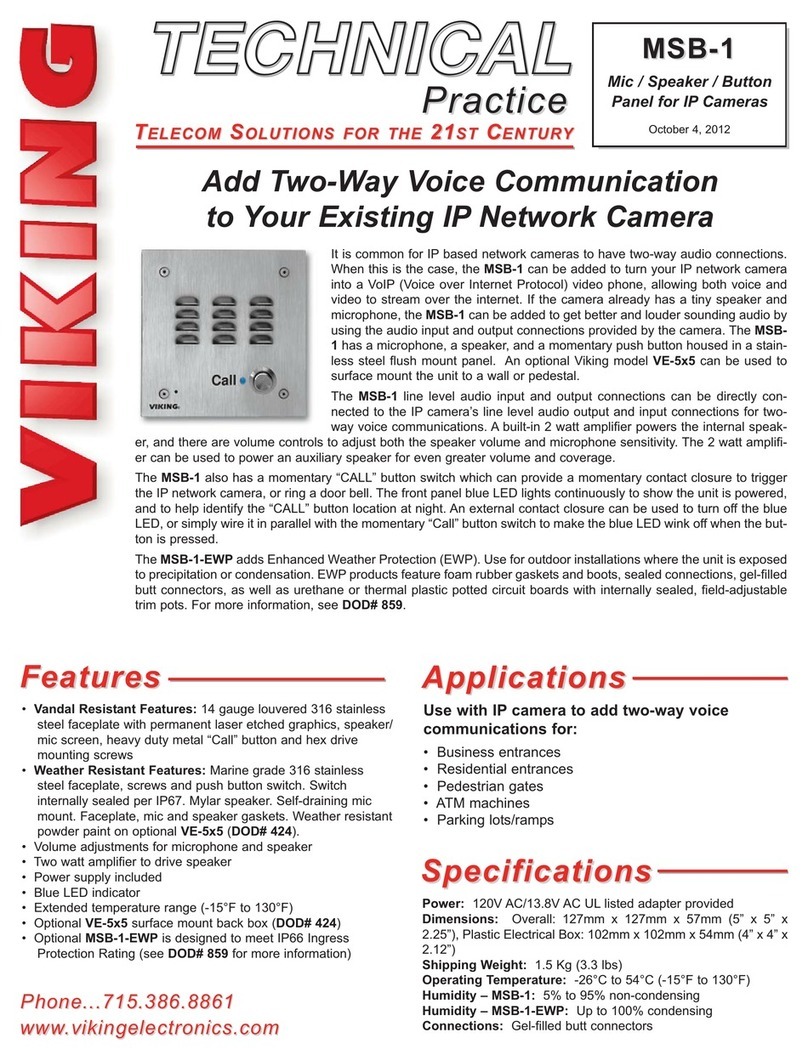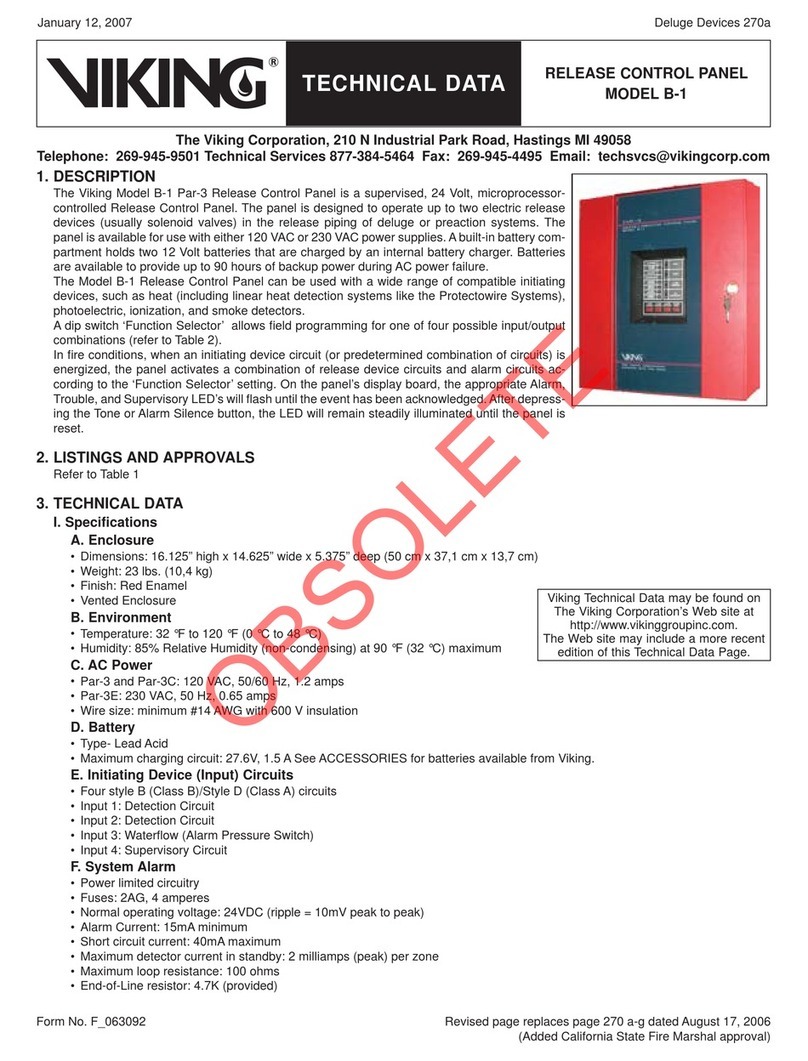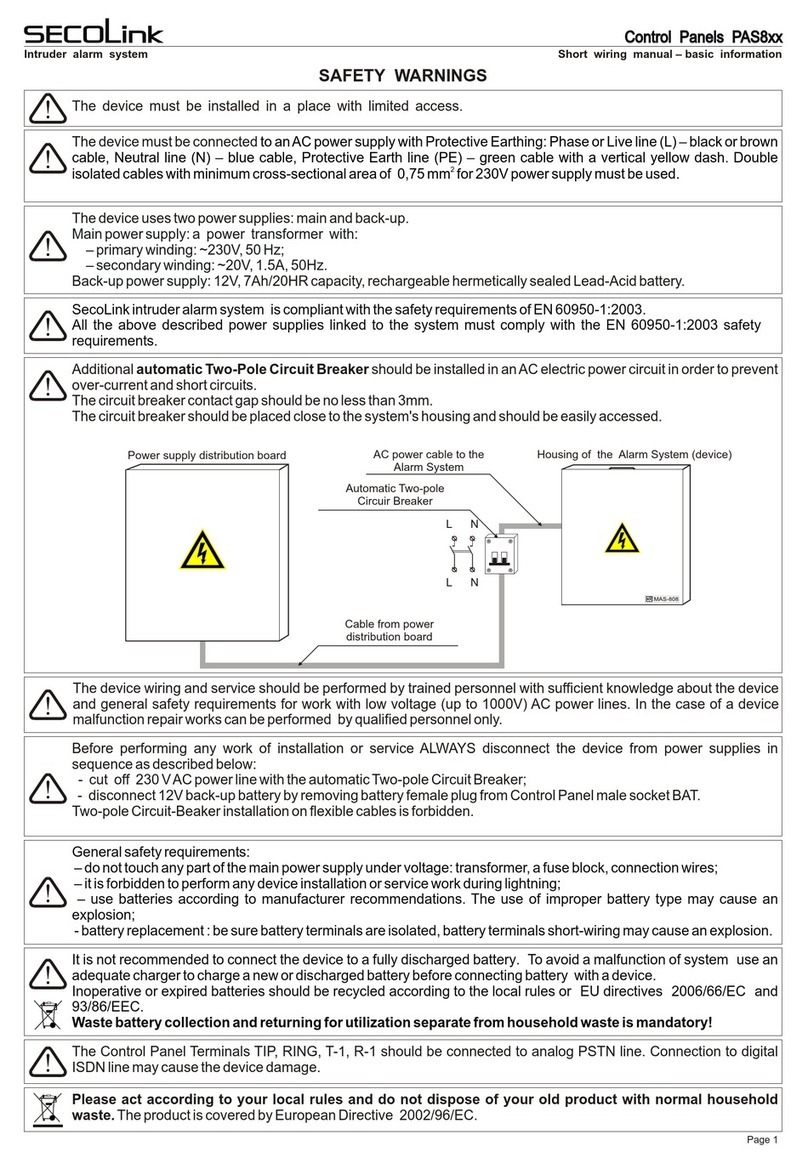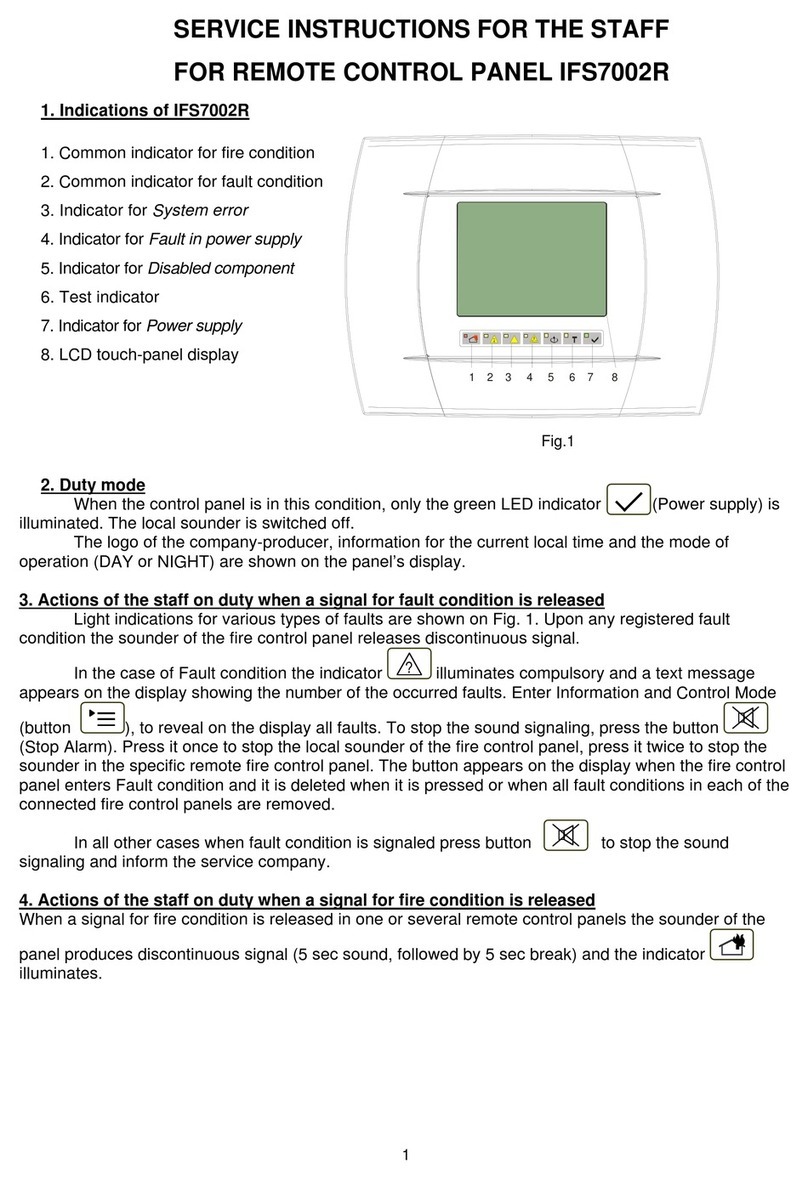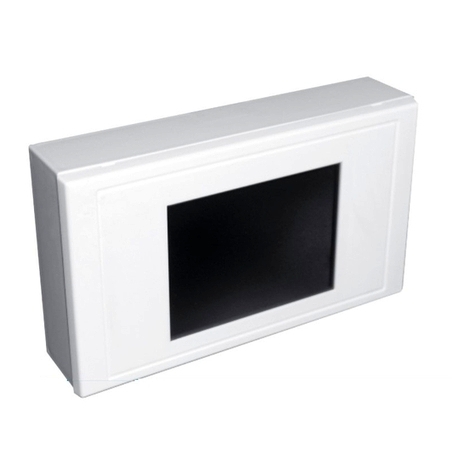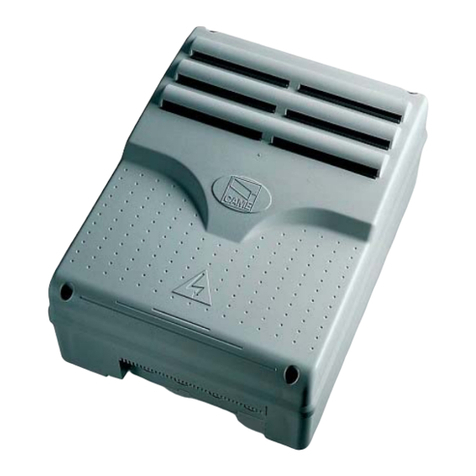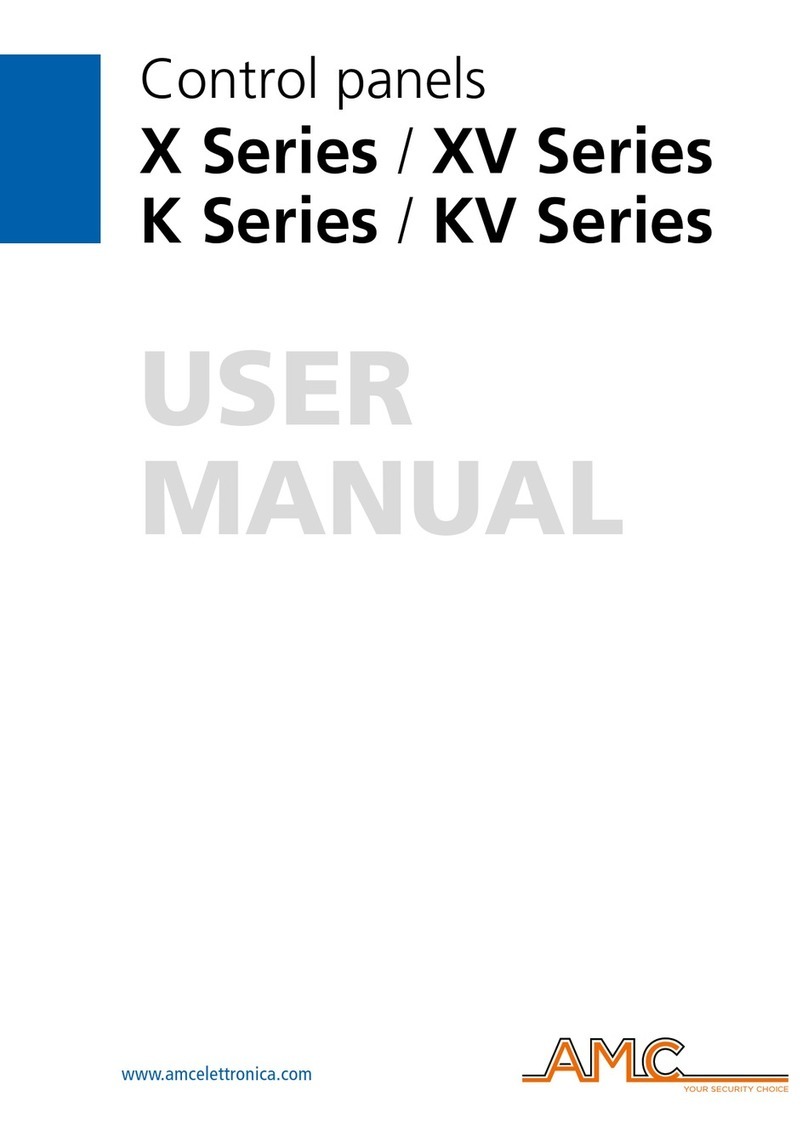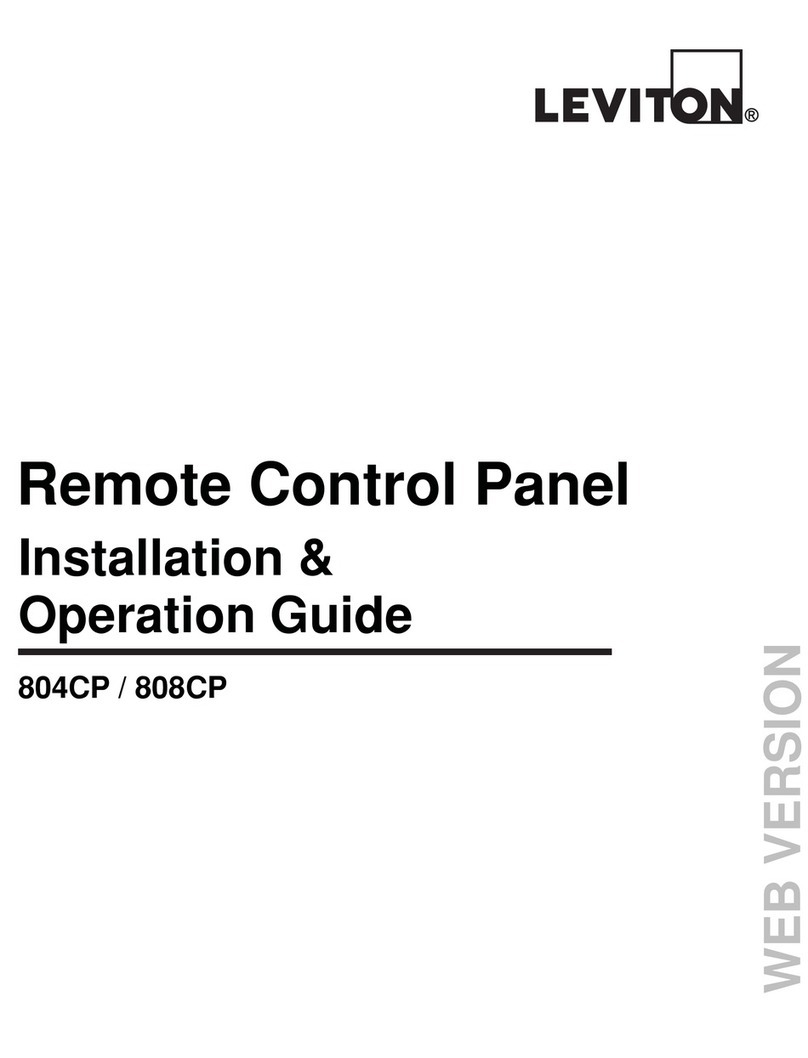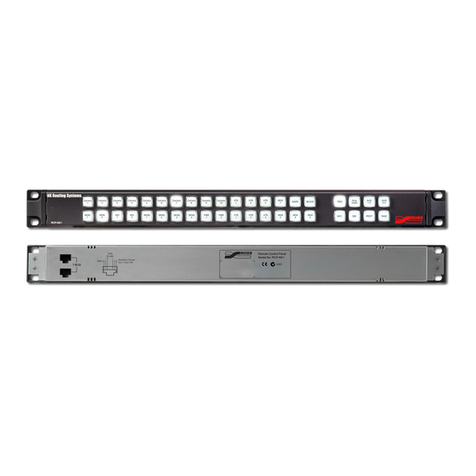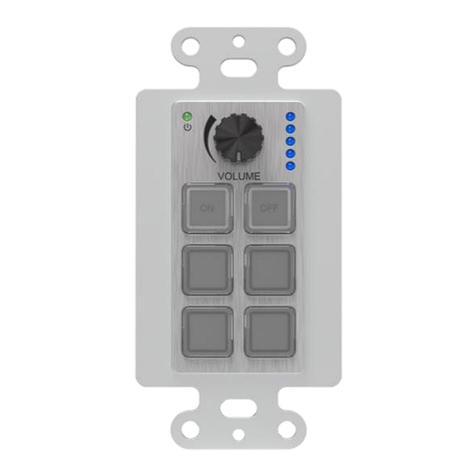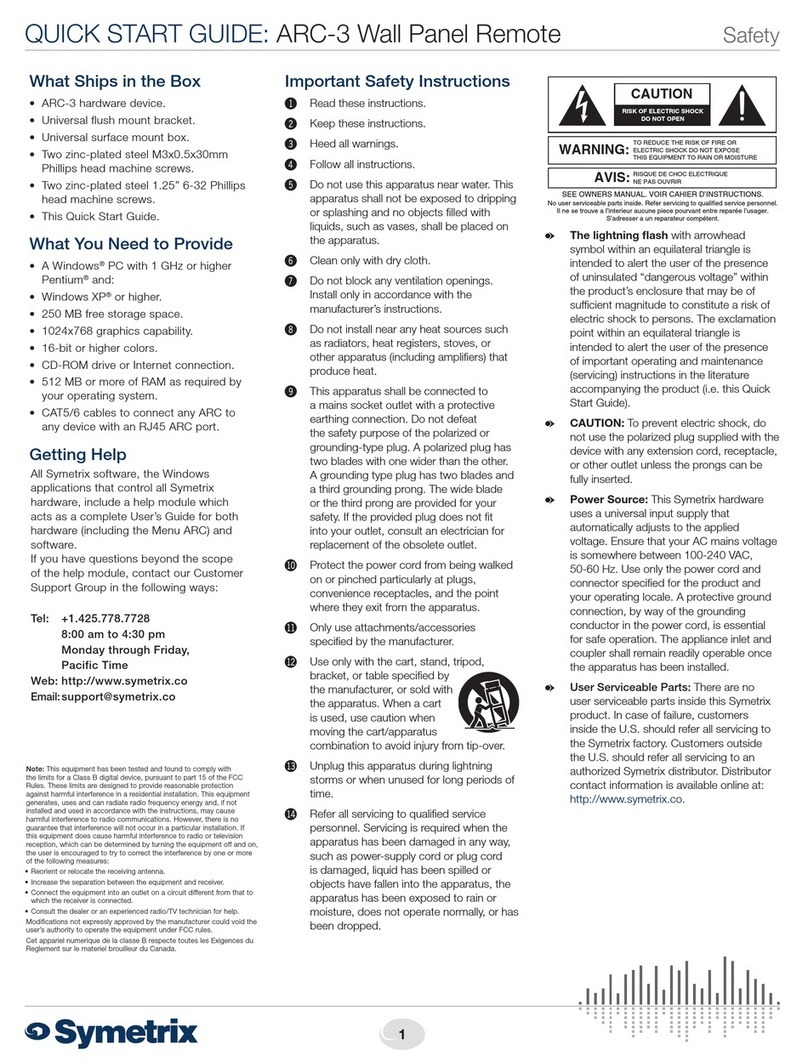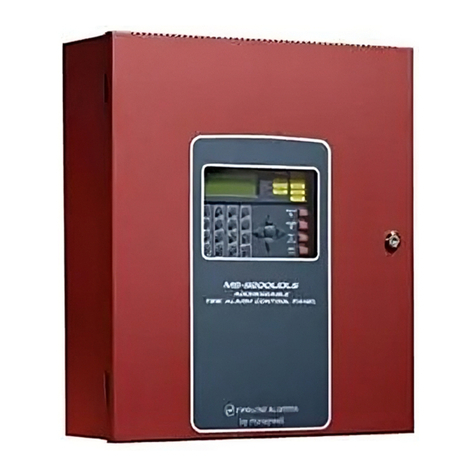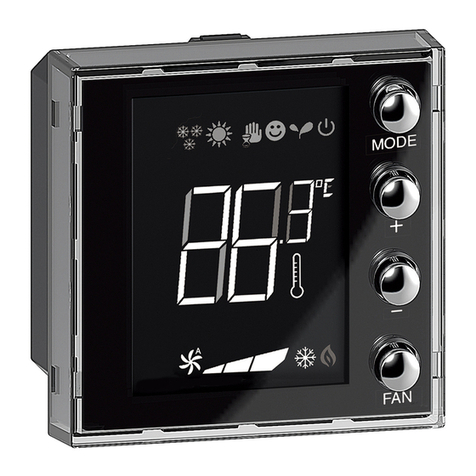Viking B-1 Instruction manual

1. PRODUCT NAME
Viking Model B-1
Release Control Panel
1991 -
2. MANUFACTURED FOR
THE VIKING CORPORATION
210 N. Industrial Park Road
Hastings, Michigan 49058 U.S.A.
Telephone: (616) 945-9501
(800) 968-9501
Fax Number: (616) 945-9599
From outside U.S.A.
Telephone: +1 (616) 945-9501
Fax Number: +1 (616) 945-9599
3. PRODUCT DESCRIPTION
The Viking Model B-1 Par-3 Panel is a
supervised, 24 Volt, microprocessor-
controlled Release Control Panel. The
panel is designed to operate up to two
electric release devices, (usually sole-
noid valves), in the release piping of
deluge or preaction systems. The panel
is available for use with either 120 VAC
or 230 VAC power supplies. A built-in
battery compartment holds two 12 Volt
batteries which are charged by an inter-
nal battery charger. Batteries are avail-
able to provide upto90 hoursof backup
power during AC power failure.
The Model B-1 panel can be used with
a wide range of compatible initiating de-
vices such as heat (includinglinear heat
detection systems such as Protectowire
Systems), photoelectric, ionization, and
smoke detectors.
A dip switch ’Function Selector’ allows
field programming for one of four possible
input/output combinations (see Table 1).
In fire conditions when an initiating de-
vice circuit (or predetermined combina-
tion of circuits) is energized, the panel
activates a combination of release de-
vicecircuitsandalarmcircuitsaccording
tothe’FunctionSelector’setting. Onthe
panel’s display board, the appropriate
Alarm, Trouble, and Supervisory LED’s
will flash until the event has been ac-
knowledged. After depressing the Tone
or Alarm Silence button, the LED will
remain steadily illuminated until the
panel is reset.
4. AVAILABILITY AND SERVICE
The Viking Model B-1 Par-3 Release
ControlPanel isavailablethroughanet-
work of Domestic, Canadian, and Inter-
national Distributors. See the Yellow
Pages of the telephone directory for
closest distributor (listed under “Sprin-
klers Automatic Fire”) or contact The
Viking Corporation.
5. GUARANTEES
Viking agrees to repair or replace goods
found to be defective in material and
workmanship for a period of one year
from the date of shipment. For details of
warranty, refer to price list.
6. TECHNICAL DATA
Approvals
See Approval Chart
Cabinet
Steel: Painted red for identification pur-
poses
Vented enclosure
Environment:
Temperature:32oF(0oC)to120oF (48oC)
Humidity: 85% Relative Humidity
(non-condensing) at 90oF (32oC)
maximum
See ACCESSORIES for wall trim avail-
able from Viking.
Dimensions:
Backbox: 16" (406mm) high, 14.5"
(368mm) wide, 4.75" (121mm) deep.
Door: 16.125" (410mm) high, 14.625"
(372mm) wide.
Cabinet: 5.375" (137mm) deep.
AC Power
Par-3 and Par-3C: 120 VAC, 50/60 Hz,
1.2 amps
Wire size: minimum #14 AWG with 600
V insulation
Par-3E: 230 VAC, 50 Hz, 0.65 amps
Wire size: minimum #14 AWG with 600
V insulation
Form No. 063092
Panel 210 a
TECHNICAL DATA
June 21, 1993
MODEL B-1
RELEASE CONTROL
PANEL
R
APPROVAL CHART APPROVALS
Model Name Power Supply Viking Part No. UL1ULC2FM NYC3
B-1 Par-3 110 VAC 50/60Hz 07907 Yes -- Yes Yes
B-1 Par-3C 110 VAC 50/60Hz 07953 -- Yes -- --
B-1 Par-3E 220VAC 50/60 Hz 07908 -- -- Yes --
1UL listed Releasing Device Control Unit (UOJZ) Model B-1
2ULC listed and CSA approved Par-3C
3Accepted by City of New York Department of Buildings MEA 89-92-E when configured for
Single Hazard-Two Zone operation (see TABLE 1) and equipped with LED Interface Module (4XLM)
and Remote Annunciator (RZA-4X). See ACCESSORIES.
New issue June 21, 1993
Note: Units of measure in parentheses may be approximations.
OBSOLETE

Battery
Lead Acid
Maximum charging circuit: 27.6V, 1.5 A
See ACCESSORIES for batteries
available from Viking.
Initiating Device (Input) Circuits
Four style B (Class B)/Style D (Class A)
circuits
Input 1: Detection Circuit
Input 2: Detection Circuit
Input3: Waterflow(AlarmPressureSw)
Input 4: Supervisory Circuit
Power limited circuitry
Fuses: 2AG, 4 amperes
Normal operating voltage: 24VDC
(ripple = 10mV peak to peak)
Alarm Current: 15mA minimum
Short circuit current: 40mA maximum
Maximum detector current in standby: 2
milliamps (peak) per zone
Maximum loop resistance: 200 ohms
End-of-Line resistor: 4.7K (provided)
Note: leave E-O-L resistors pro-
vided, on all unused circuits.
Detector loop current is sufficient to en-
sureoperation ofone alarmed detec-
tor per zone.
Supervisory current: 5mA (including
End-of-Line Resistor)
Heat Detectors: Detectioncircuits allow
for installation of any number of
listed or approved normally open
thermal detectors.
Smoke Detectors: Contact the Viking
Distributor for a list of compatible
smoke detectors, information con-
cerning the maximum number of
smoke detectors allowed per zone,
and standby power requirements for
the smoke detector used. Also, refer
to appropriate Fire Protection Equip-
ment Approval Guides.
For supervised four-wire smoke detec-
tors, connect the Power Supervision
Relay to the last detector base 24V
screw terminals.
See ACCESSORIES.
Indicating Appliance and Releasing
(output) Circuits
Two Style Y and two Style Y/Z circuits
Output 1: Alarm Bell(Style Y/Z)
Output 2: Waterflow or Trouble Horn
(Style Y/Z)
Output 3: Releasing Circuit 1(Style Y)
Output 4: Releasing Circuit 2 or
Trouble Horn(Style Y)
Normal operating voltage: 24VDC
Total current available to all four circuits
+ RMS regulated power output cir-
cuit, not to exceed: 2.25 AMPS
Maximum signaling current per circuit:
2.25 AMPS
Supervised Circuitry
Power limited circuitry (except for Mu-
nicipal Box output)
Fuses: 2AG, 4 amperes
Maximum allowable voltage drop due to
wiring: 2 VDC.
End-of-Line resistor: 4.7K (provided)
Note: leave E-O-L resistors pro-
vided, on all unused circuits.
Note: Wiring must be configured to
maintaina minimumvoltageof 20.4V
on release circuits.
Contact the Viking Distributor fora list of
compatibleindicatingappliancesand
releasing devices. Also, refer to Vi-
king Technical Data and appropriate
Fire Protection Equipment Approval
Guides.
Alarm Relay
Basic panel includes one non-silence-
able Form-C dry alarm contact rated
2 amps at 30 VDC and 0.5 amps at
30 VAC (resistive).
Trouble Relay
Basic panel includes one Form-C dry
alarm contact rated 2 amps at 30
VDC and 0.5 amps at 30 VAC(resis-
tive). Trouble relay will silence when
trouble condition is cleared.
Zone Relay Module
Model B-1 Panels include one Zone Re-
lay Module (4XZM) providing dry
Form-C contacts controlled by each
of the four output circuits plus one
general alarm and one panel/field-
wiring trouble relay. See TABLE 2.
Power Outputs
Four-wire Smoke Detector Power (re-
settable): Up to 200 mA total (four-
wiresmoke detector power plus non-
resettable power combined) DC cur-
rent available. Maximum ripple volt-
age: 10mV p/p.
Non-resettable Power: Up to 200 mA
total(four-wiresmokedetectorpower
plusnon-resettablepowercombined)
DC current available.
Maximum ripple voltage: 10mV p/p.
RMS Regulated Power: Total current
available for external devices: 0.5
amp (subtracted from 2.25 A avail-
able to indicating appliance circuits)
DC current available.
Maximum ripple voltage: 100mV p/p.
7. OTHER FEATURES
Front Panel Control Switches: (Refer to
Figure 1).
Switch 1: Tone Silence
Switch 2: Alarm Silence
ToneSilenceandAlarmSilencecon-
trol switches can be activated to ac-
knowledge alarms. A second
"trouble" will resound the piezo.
Switch 3: Alarm Activate
The Alarm Activate switch may be
used to activate indicating circuits
and relays.
Switch 4: System Reset
The Reset switch clears any acti-
vated output circuits. If alarm or
trouble conditions exist when the re-
set switch is pushed, they will re-ac-
tivate the panel.
Front Panel Zone Status LEDs
When the panel is activated, zone
status LED’s illuminate, to indicate
the status of Zone 1, Zone 2, Alarm
Pressure, and Auxiliary Supervisory
circuits.
Alarm (red) LED’s indicate activation
of a detection device.
Trouble (yellow) LED’s indicate elec-
trical circuit failure such as short cir-
cuits and loose wires.
Front Panel System Status LEDs
The presence of AC Power is indi-
cated by a constant green LED, indi-
cating normal conditions.
Alarm (red), Trouble (yellow), and
Supervisory (yellow) LED’s activate
asrequiredtoindicateSystemAlarm,
Release operation, Supervisory De-
vice activation, and Circuit trouble.
LED’s also illuminate to indicate
when the Alarm Silence switch has
been activated.
Piezo Sounder
Alarm signals are latching
Trouble signals are self restoring
Alarm and Trouble resound
Last Event Recall
Follow procedure printed in Par-3
Owners Manual provided with panel.
Zone Disable Function
Follow procedure printed in Par-3
Owners Manual provided with panel.
Battery Fail and Earth Fault supervision
(see Figure 1 for location of LEDs)
Dischargetimeroption:latched,10or15
minutes.RefertoPar-3Ownersman-
ual included with panel. Also refer to
installation standards, Technical
Data, and all Authorities Having Ju-
risdictionwhenusingtimerconfigura-
tions.
Output circuits protected against false
activation by two step command se-
quence
Slide in zone identification labels
Spare labels included in Par-3 Own-
ers Manual provided with panel.
Panel 210 b
TECHNICAL DATA MODEL B-1
RELEASE CONTROL
PANEL
June 21, 1993
R
OBSOLETE

8. ACCESSORIES
(order separately)
Batteries:
Two batteries of the same AH rating are
required.
12V 7 Amp-Hour Viking PN 07920
12V 12 Amp-Hour Viking PN 07921
Plug-inconnectorisprovidedwiththe
Panel.
See POWER CALCULATIONS to
determine which batteries meet
standby battery requirements.
Zone Relay Module (4XZM): Model B-1
panels can accommodate a second
4XZM Zone Relay Module (one in-
cluded in each panel) or one of the
following two Modules:
Transmitter Module (4XTM) (Viking PN
07909) provides a supervised output
for local energy municipal box trans-
mitter and alarm and trouble reverse
polarity circuits.
LED Interface Module (4XLM) (Viking
PN 07910) for Remote Annunciator
(RZA-4X)describedbelow(Required
for NYC approval).
Remote Annunciator (RZA-4X) (Viking
PN 07911) Mounts on standard sin-
gle-gang box. (LED Interface Module
(4XLM)describedaboveisrequired).
Provides "System Trouble" LED
Local Piezo Sounder
Silence Switch (for local sounder)
Alarm/Waterflow Bell LED
Waterflow/Supervisory Bell LED
Releasing Circuit 1 LED
Supervisory Bell/Release Circuit 2
LED.
End-of-Lineresistor:4.7K,1/2Watt,with
terminal connector both ends, (for
two-wire supervised circuits) Viking
PN 07913
Power Supervisory Relay Coil (for four-
wire smoke detector circuits) (Viking
PN 07919)
Voltage & Current Meters (4XZMM) (Vi-
kingPN07917)mountinsidecabinet.
Digital Communicator NOTI-FIRE 911
(Viking PN 07918) Kit For Central
Station service.
9. INSTALLATION
Prior to installation, review the Par-3
Owners Manual and Viking Field Wiring
Diagrams. (See package inside Panel.)
Observe all instructions provided in the
Par-3 Owners Manual.
Field wiring must be according to VI-
KING FIELD WIRING DIAGRAMS for
the specific mode of operation required.
See TABLE 1.
All wiring should be done in accordance
with National and/or Local codes for fire
alarm systems.
The Authority Having Jurissdiction may
have additional requirements.
A. Mount the cabinet in a clean, dry,
vibration-free area where tempera-
ture and humidity conditions do not
exceed limitations indicated in
TECHNICAL DATA.
B.Verifythatallinitiatingdevices(detec-
tors) indicating appliances, and re-
leasing devices are compatible with
the Model B-1 Release Control
Panel.
ContacttheVikingDistributorforalist
of compatible devices. Also, refer to
appropriate Fire Protection Equip-
ment Approval Guides.
C. Wire all alarm initiating devices se-
quentially for proper supervision.
D. Pull required conductors through the
knockouts provided.
E.Priortoconnectingtothepanel,verify
continuity of all circuitry.
F.Priortoconnectingtothepanel,check
for, and correct any short circuits.
G.Makeelectricalconnectionstocontrol
panel for the detection,supervisory,
alarm, trouble, and release circuits,
according to appropriate VIKING
FIELD WIRING DIAGRAMS for the
systemusedandtheOwnersManual
provided with the panel.
1:WhereindicatedonVIKINGFIELD
WIRING DIAGRAMS, install the
4.7 K Ohm 1/2 Watt End of Line
Resistor(providedinpanel)at the
remote end of circuit. End Of
Line Resistors should NOT be in-
stalled across Release Circuits.
2: On all un-used circuits, leave the
4.7 K Ohm 1/2 Watt End of Line
Resistor (provided in panel) in
place.
3: Maintainpolarity onalarmbelland
trouble bell circuits.
Do not energize the panel until all asso-
ciated, modules, and interconnecting
cables have been connected.
H. Prior to energizing the panel:
1: Verifythatdipswitchescontrolling
panel operation are in the proper
position for the system used. Re-
fertoTABLE1andVIKINGFIELD
WIRING DIAGRAMS.
2:Verifythatallmodulesaresecurely
and properly positioned on their
pins. If a module is loose, care-
fully align all pins and press firmly
into position.
I. Connect non-energized AC power to
the panel. Refer to Figure 1 and VI-
KING FIELD WIRING DIAGRAMS.
1:Connectthewireprovidingin-com-
ing voltage to the trminal marked
"H".
2: Connect the neutral wire to the
terminal marked "N".
3: Connect the groung wire to the
terminal mrked "G".
J. Procedure for connecting Batteries:
Note: Two Battery plug/wire assem-
blies (long leads with plug) and
jumper (short) wires are provided
with each panel. Connectors on one
plug/wire assembly fit 7.0 AH Batter-
ies. Connectors on the other
plug/wire assembly fit 12.0 AH Bat-
teries.
1: Position batteries end to end with
terminals adjacent. Select the
proper plug/wire assembly for the
batteries used.
2: Connect the long RED lead to the
positive terminal of one battery,
and the long black lead to the
negative terminal of the other.
3: Place batteries inside the battery
compartment of the Par-3 Panel
with the unused terminals toward
the open door. Install batteries in
the upright position only.
4: Plug the plug-in connector to J9
on the main board of the panel.
(refer to Figure 1 and VIKING
FIELD WIRING DIAGRAMS). Do
NOT install jumper at this time.
To energize the panel and place the
system in service:
K. Energize the AC power supply to the
panel. The Piezo will sound, and the
"System Trouble" and "Power
Trouble" LEDs will flash.
L. Use the jumper (short) wire to con-
nect the unused negative terminal of
one battery with the unused positive
terminal of the other battery. The
Piezo should silence, and the "Sys-
tem Trouble" and "Power Trouble"
LEDs should stop flashing.
M. Perform appropriate tests to verify
proper operation of the system.
N. After placing the system in service,
close and lock the panel to prevent
tampering with the unit.
Wheninstallingoptionalcards,modules,
inter-connectingcables,or otherassoci-
ated equipment, refer to MAINTE-
NANCE, technical data for the optional
equipment, and Owners Manual pro-
vided with the panel.
TECHNICAL DATA
June 21, 1993
MODEL B-1
RELEASE CONTROL
PANEL
Panel 210 c
R
OBSOLETE

10. MAINTENANCE and
TESTING
NOTICE: The owner is responsible for
maintaining the fire protection system
and devices in proper operating condi-
tion. The Viking Model B-1 Release
Control Panel must be kept free of for-
eign matter and environmental condi-
tions that could impair it’s operation.
For minimum maintenance and inspec-
tion requirements, refer to the National
Fire Protection Association Pamphlet
that describes care and maintenance of
sprinkler systems. In addition, the
"Authority Having Jurisdiction" may
have additional maintenance, testing,
andinspectionrequirementswhichmust
be followed.
WARNING: Any system maintenance
that requires placing a control valve or
detection system out of service may
eliminate the fire protection capabilities
of that system. Prior to proceeding, no-
tify all Authorities Having Jurisdiction.
Consideration should be given to em-
ployment of a Fire Patrol in the affected
areas.
Tests
Prior to proceeding with tests:
A. verify that installation complies with
instructions in the Owners Manual
provided with the panel and the ap-
propriate VIKING FIELD WIRING
DIAGRAMS for the system used.
B. Notify the Authority Having Jurisdic-
tion andall those in the area affected
by the test.
Alarm Activate Switch
TotestAlarmbell, Waterflowbellcircuits
andAlarm,Detection,andWaterflow re-
lays:
1: Push "Alarm Activate" (See Figure
3).
Note: "Alarm Activate" is a latch-
ing function. "Alarm Silence" will
silence indicating circuits and
System Alarm Relay and light the
Alarm Silenced LED.
2: When test is complete, push"Sys-
tem Reset" Conditions should re-
turn to normal.
Waterflow
To test Water Flow Alarm on Viking pre-
action and Viking deluge systems: Con-
sult technical literature for the system
used.
1:TurntheAlarmTestValveto"Test"
position. See figure 3 for output
circuits and relays that should ac-
tivate for the system used. "Wa-
terflow" circuits are latching.
2: When test is complete return the
Alarm Test Valve to the normal
position and push "System Re-
set". Conditions should return to
normal.
Detection
To test detection circuits:
1: Close main water supply control
valve, placing the system out of
service.
Caution! For DelugeandSingle orNon-
interlocked preaction systems, perform-
ing this test results in operation of the
Deluge Valve. Failure to close the main
water supply control valve will cause
water to flow into the sprinkler piping.
Caution! For Double-Interlocked sys-
tems, simultaneous operation of a de-
tector, andlowering of supervisory pres-
sure in the sprinkler piping will result in
operationoftheDelugeValve.Failureto
close the main water supply control
valve will cause water to flow into the
sprinkler piping.
Caution! Simultaneous operation of
both detection circuits on any system
utilizing cross-zone detection, will result
inoperationoftheDelugeValve. Failure
to close the main water supply control
valve will cause water to flow into the
sprinkler piping.
2: Operate individual detectors, fol-
lowing instructionslistedintechni-
caldataforthedetectorused.See
TABLE 2 for output circuits and
relays that should activate for the
system used. "Detection" circuits
are latching (except when config-
ured for optional "timed shut-off".
See Owners Manual).
3:WhenTestiscomplete,push"Sys-
tem Reset". Conditions should re-
turn to normal.
4: Refer to technical data for the sys-
temused toopenmainwatersup-
ply control valve, and place the
system back in service.
Maintenance
CAUTION: Disconnect all power
sources before servicing. The panel
and associated equipment may be
damaged by removing and/or insert-
ing cards, modules, or interconnect-
ing cables while the panel is ener-
gized.
TECHNICAL DATA MODEL B-1
RELEASE CONTROL
PANEL
Panel 210 d June 21, 1993
R
OBSOLETE

Panel 210 e
TECHNICAL DATA MODEL B-1
RELEASE CONTROL
PANEL
June 21, 1993
R
TABLE 2
Charts show Output and Relay Module Circuits Activated by Detection Circuits
Note: Dip Switches 3, 4, and 5 MUST be OFF to disable timer capabilities of the panel. For information concerning timer
capabilities, refer to PAR-3 Owners Manual. Also refer to installation standards, Technical Data, and all Authorities
HavingJurisdiction when using timer configurations.
TABLE 1
Dip Switch Settings for System Configuration Modes
OBSOLETE

TECHNICAL DATA MODEL B-1
RELEASE CONTROL
PANEL
R
Figure 1
June 21, 1993
Panel 210 f
Form No. 063092
OBSOLETE
Table of contents
Other Viking Control Panel manuals
Popular Control Panel manuals by other brands
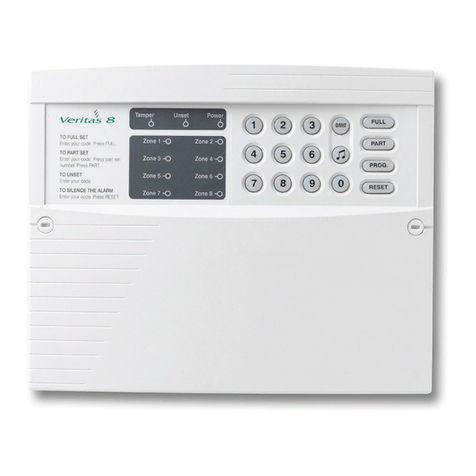
Texecom
Texecom Veritas 8 installation manual
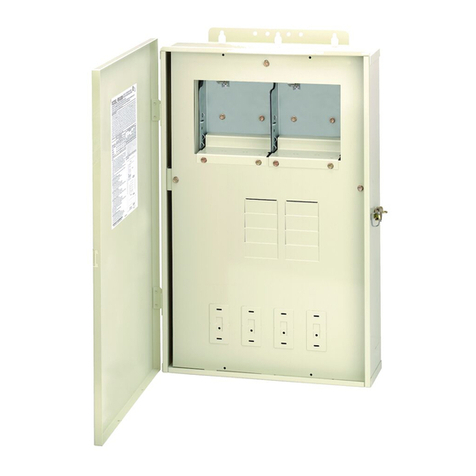
Intermatic
Intermatic PE30000 Series Installation, operation & service manual
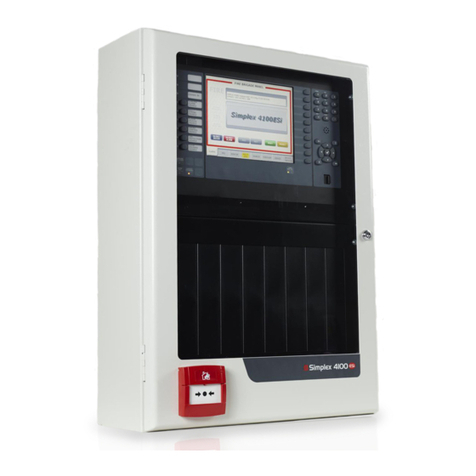
Simplex
Simplex 4100ESi Wiring diagrams
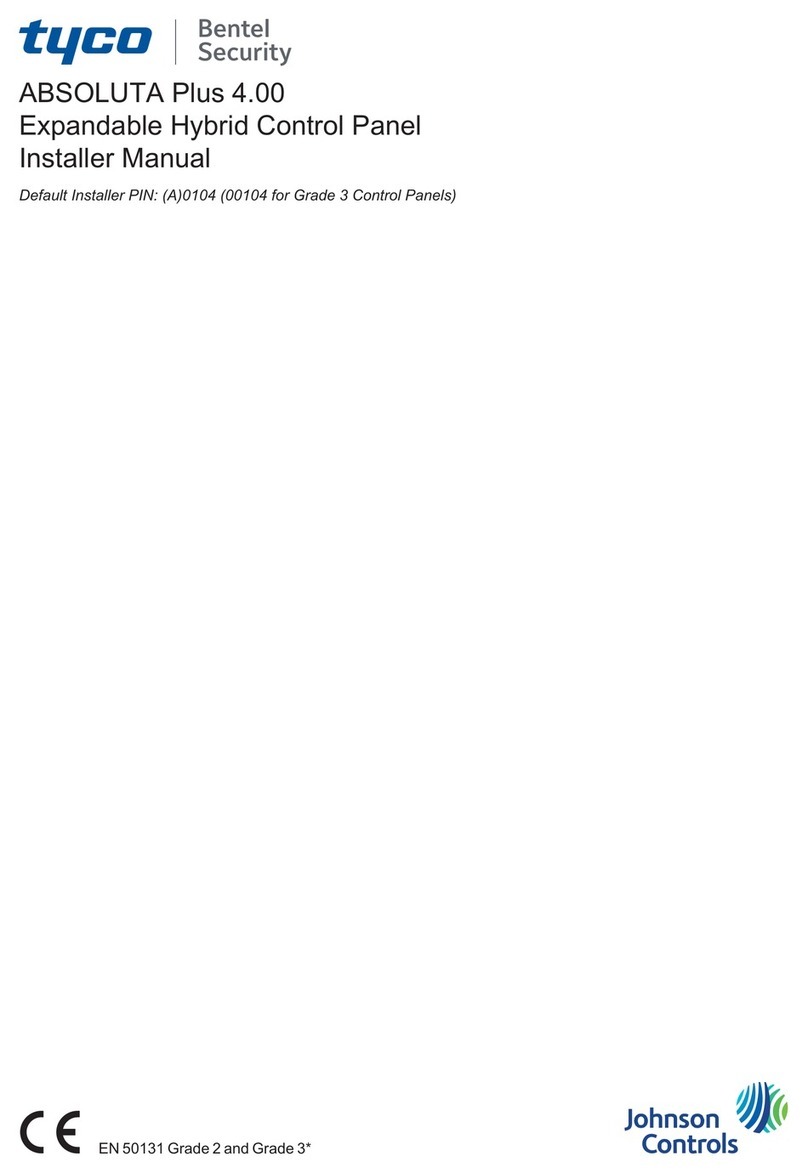
Johnson Controls
Johnson Controls Bentel Security tyco ABSOLUTA Plus Installer manual
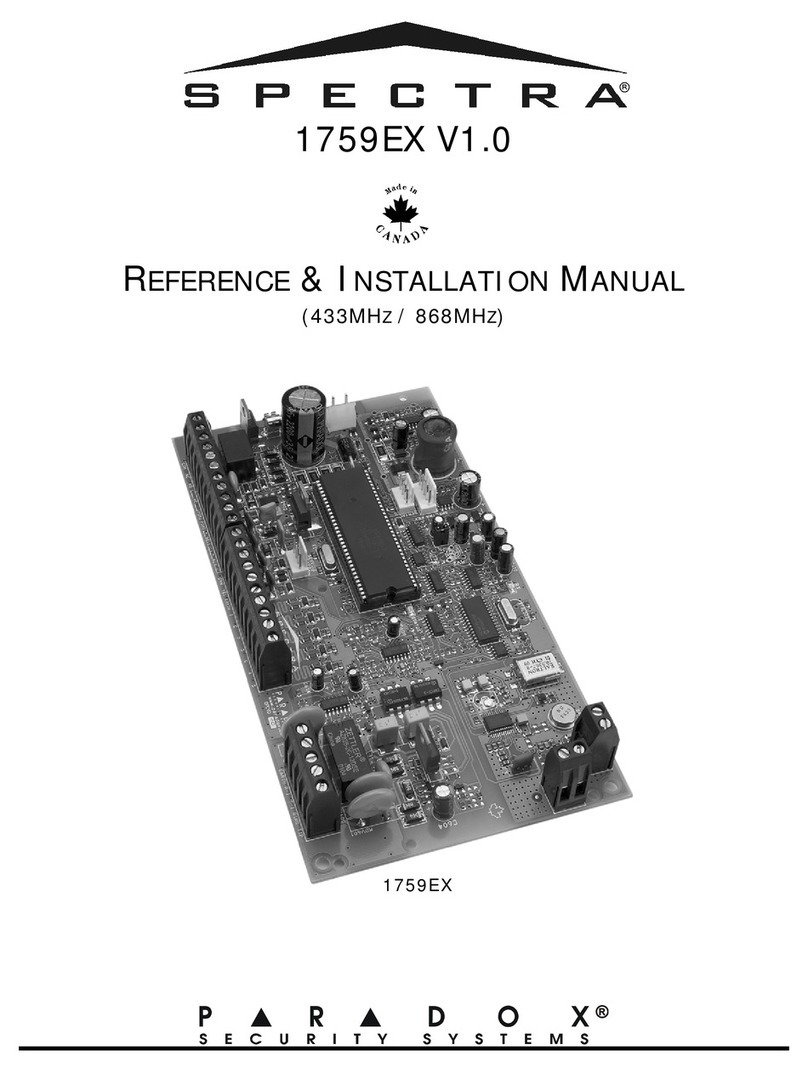
Spectra
Spectra 1759ex Reference and installation manual
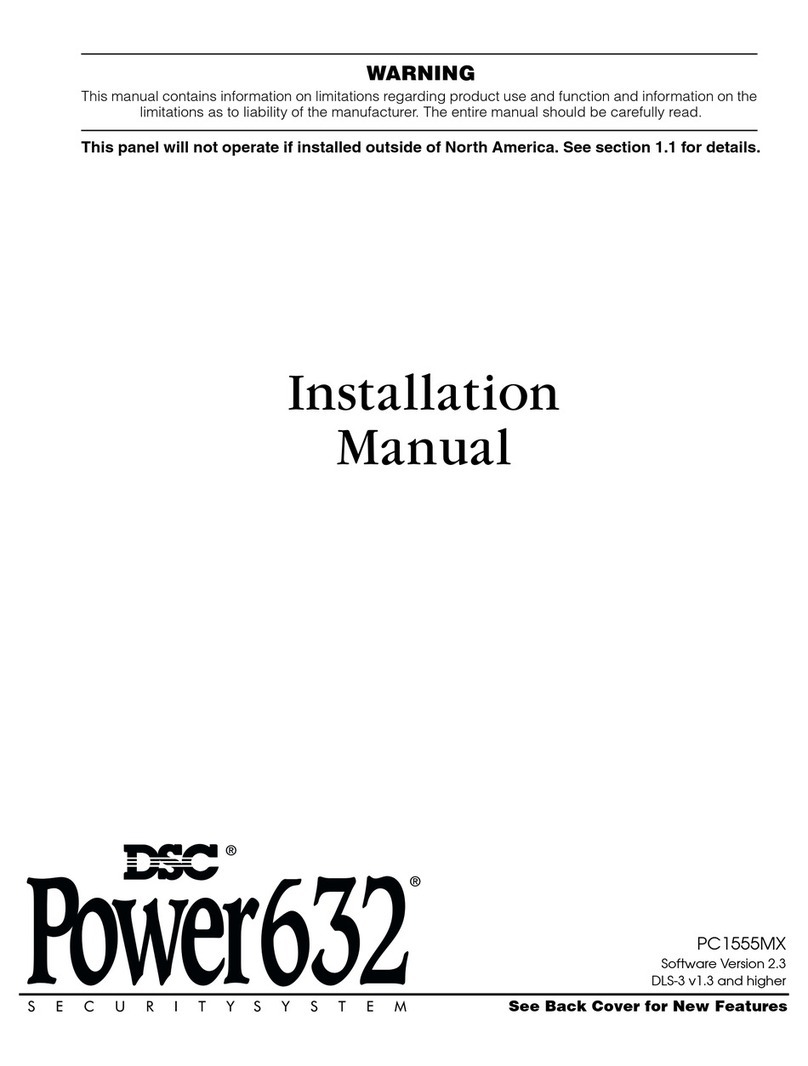
DSC
DSC Power632 DSCPC1555RKW installation manual


